As a survivalist and hunter, I go through a good amount of ammunition. This includes both bullets and shotgun shells.
Whether I am out tracking down game or enjoying target practice after a stressful day, there are shell casings left over. With such an abundant resource, I would not be a good prepper and survivalist if I threw them away.
The obvious solution is to reload my own ammunition. While I know how to reload ammo and have the supplies, I simply don’t have time to reload all of it. If times were tougher and I was hunting every day, I would take the time to reload everything.
In the meantime, there are lots of additional ways to repurpose brass casings and plastic shotgun shells.
There are many crafty projects for these leftovers, but I wanted to put together a list of practical uses. Most of these would be ideal for a survival scenario.
Related: How to Make Shotgun Shells at Home? (With Pictures)
Working With Brass Casings
Brass is a fairly soft metal, so it is relatively easy to cut and bend it. You can use it for decorative purposes, but it is more functional in bearings and seals for machinery. It does not spark, so you can use it around volatile substances like gasoline. It melts easily, so you can melt it down to form it into other shapes.
For cutting brass you can use just about any saw or heavy blade. You can use a grinder, a file, or even rub the casing on concrete to sand it down. For a flat piece of brass, you just need to cut off the closed end with the primer. From there you just hammer it flat. You can drill through it with any kind of bit or can even use the point of your knife to punch a hole.
Repurposing Shotgun Shells
Shotgun shells are made of plastic, so they are even easier to cut. Any sharp blade will do. You can cut just above the brass to remove the plastic.
However, the cleanest way to remove the plastic is to heat the brass. If you flip a clothes iron upside down and set the brass portion on top, it will start to heat up. With just a little heat, the plastic will pull free leaving the brass portion separate. Be sure to clean out your shells first so there is no residual left to catch fire.
Here are the functional ways you can reuse your casings and shells:
Emergency Whistle
In a survival scenario, it is vital that you have a way to alert people of your presence. This could be to alert rescuers, or it could be just to communicate with your family.
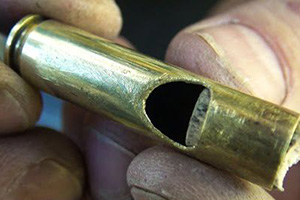
A good survival whistle is perfect for this.
The sound will cut through the wind better than just yelling, and it won’t wear out your voice.
Long casings for pistols are best, but you can cut the taper off of rifle casings as well.
Cut a notch with the edge closest to the opening perpendicular to the length of the shell. The other side of the notch should be 30 to 45 degrees off parallel. Find a stick that tightly fits inside the casing. Make sure the end of the stick is completely flat. Then shave down the side facing the notch so there is a little gap for air.
When you push in the stick, it should make a whistling sound.
Sinkers For Fishing
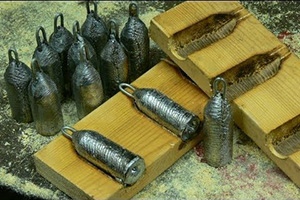 It is always nice to have a variety of different weights available to attach to your fishing line.
It is always nice to have a variety of different weights available to attach to your fishing line.
Brass casings work great for this. Just fill your brass with sand and pound the open end shut.
Cut a hole for your line and you are ready to fish.
Related: How to Catch Fish with a Jug
Chimes
Larger casings will work better for this project if you want a good amount of volume. These work great for tripwire perimeter alarms or just to let you know when the wind is blowing.
Just cut off the closed end and punch holes to attach strings to each shell. String them up on a frame and you have chimes.
Dog Tags
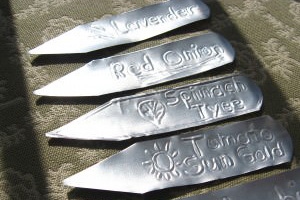 When I refer to dog tags, I really mean just a metal label. It could be for your pets, to label your keys, or it could be for labelling products in your garage. You just need to cut off the primer end and pound the casing flat. Punch a hole in one side. Then just stamp any info you would like using a normal metal stamp.
When I refer to dog tags, I really mean just a metal label. It could be for your pets, to label your keys, or it could be for labelling products in your garage. You just need to cut off the primer end and pound the casing flat. Punch a hole in one side. Then just stamp any info you would like using a normal metal stamp.
Shims
Sometimes you need a spacer or a shim to fill in a small gap on equipment or in the joints of a wooden project. The thin sheets of brass you get from flattening a shell casing is perfect for this job. Just put in as many sheets as you need for the thickness and cut off any excess brass.
Arrowheads
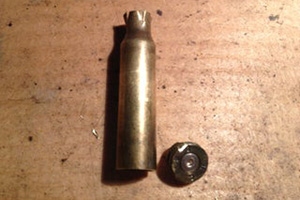 To make arrowheads out of brass casings, start by flattening the casing.
To make arrowheads out of brass casings, start by flattening the casing.
Cut off the end and then pound it flat. Cut out the shape you want remembering to have a good shape to attach the arrowhead to an arrow shaft. Sharpen both edges and you are ready to go hunting.
Seals
If you have a piece of equipment made of a harder metal like steel, it may need a seal to maintain pressure. A soft metal can be cut to shape and installed in the junction to seal and maintain pressure.
Colored Lens For A Flashlight
Having colored light at night can be helpful in a survival scenario.
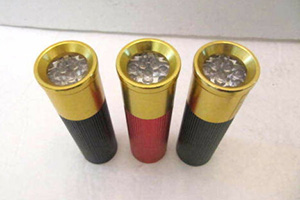
Red light does not disrupt night vision like white light does. Green light is ideal for hunting hogs at night. Any color can be used to turn your flashlight into a signal.
Just remove the brass from the plastic shell and flatten the plastic with a heat gun. Then cut it to the correct size and attach it to your light.
Drawer Handles
Shotgun shells make good handles as they are brightly colored and easy to grab. For tools or equipment, just add epoxy inside the shell and press the tool or equipment lever into the epoxy.
Let it dry and you are good. For drawer pulls just put a screw in the epoxy with the pointed end facing out.
Bearings
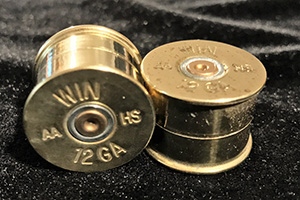 Brass is great for bearings in machinery to prevent metal rubbing on metal. In some cases, you can use the primer end as is. In others it would need to be melted down to cast a bearing.
Brass is great for bearings in machinery to prevent metal rubbing on metal. In some cases, you can use the primer end as is. In others it would need to be melted down to cast a bearing.
Related: 25 Powerless Appliances for Your Homestead Kitchen
Buttons
For quick buttons just cut off the primer end of a shotgun shell or brass casing. Then drill holes and you are good to go.
Candles
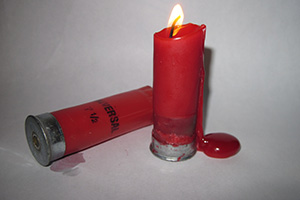 Shotgun shells are ideal in size and shape for emergency candles. They are small enough to put in your pocket, but large enough to stay lit for an hour or so.
Shotgun shells are ideal in size and shape for emergency candles. They are small enough to put in your pocket, but large enough to stay lit for an hour or so.
The shell itself keeps the wax from getting all over everything. Just add a wick and some melted wax and let it set up.
Push Pins
If you are planning a foraging grid or a route for bugging out, you will need to mark landmarks on a map.
Push pins are easier to use if they have a shell casing attached. Just find push pins that fit inside the casing and glue them in place. They are less likely to end up in your carpet or your foot that way.
Grommets
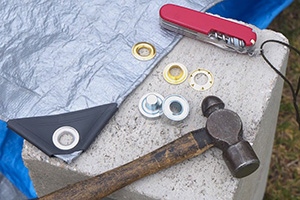 Brass Grommets are needed at the corners of tarps and other things to prevent them from fraying when attached to cordage.
Brass Grommets are needed at the corners of tarps and other things to prevent them from fraying when attached to cordage.
You can cut the primer end off of either shotgun shells or brass casings.
Then pop out the primer itself and you have your grommet.
As you can see, there are lots of uses for your discarded brass casings and shotgun shells. You just need to take the initiative to try out a few of these projects. Start collecting all of your casings and shells. When SHTF, you will be ready to use these to their maximum potential.

No comments:
Post a Comment